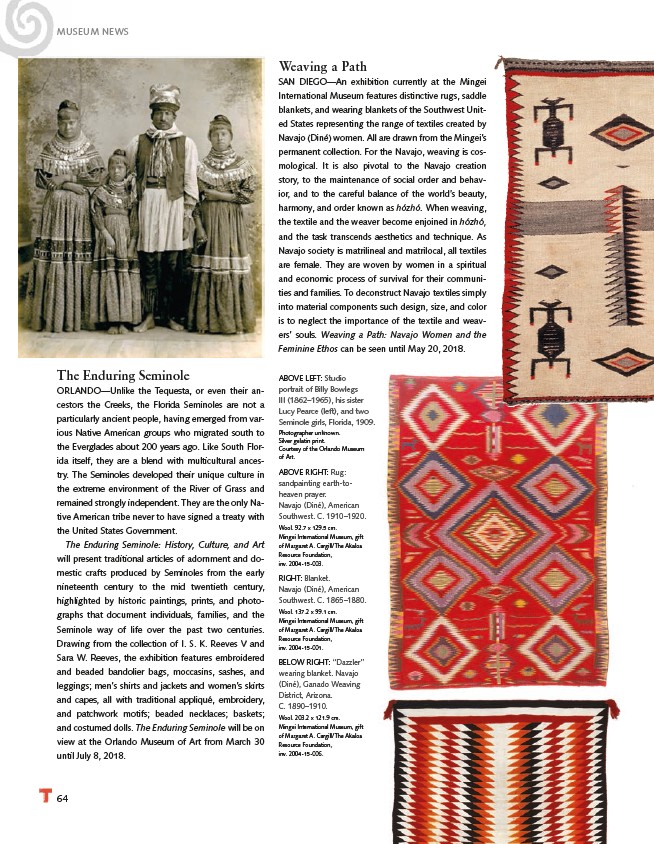
MUSEUM NEWS
64
Weaving a Path
SAN DIEGO—An exhibition currently at the Mingei
International Museum features distinctive rugs, saddle
blankets, and wearing blankets of the Southwest United
States representing the range of textiles created by
Navajo (Diné) women. All are drawn from the Mingei’s
permanent collection. For the Navajo, weaving is cosmological.
It is also pivotal to the Navajo creation
story, to the maintenance of social order and behavior,
and to the careful balance of the world’s beauty,
harmony, and order known as hózhó. When weaving,
the textile and the weaver become enjoined in hózhó,
and the task transcends aesthetics and technique. As
Navajo society is matrilineal and matrilocal, all textiles
are female. They are woven by women in a spiritual
and economic process of survival for their communities
and families. To deconstruct Navajo textiles simply
into material components such design, size, and color
is to neglect the importance of the textile and weavers’
souls. Weaving a Path: Navajo Women and the
Feminine Ethos can be seen until May 20, 2018.
ABOVE LEFT: Studio
portrait of Billy Bowlegs
III (1862–1965), his sister
Lucy Pearce (left), and two
Seminole girls, Florida, 1909.
Photographer unknown.
Silver gelatin print.
Courtesy of the Orlando Museum
of Art.
ABOVE RIGHT: Rug:
sandpainting earth-toheaven
prayer.
Navajo (Diné), American
Southwest. C. 1910–1920.
Wool. 92.7 x 129.5 cm.
Mingei International Museum, gift
of Margaret A. Cargill/The Akaloa
Resource Foundation,
inv. 2004-15-003.
RIGHT: Blanket.
Navajo (Diné), American
Southwest. C. 1865–1880.
Wool. 137.2 x 99.1 cm.
Mingei International Museum, gift
of Margaret A. Cargill/The Akaloa
Resource Foundation,
inv. 2004-15-001.
BELOW RIGHT: “Dazzler”
wearing blanket. Navajo
(Diné), Ganado Weaving
District, Arizona.
C. 1890–1910.
Wool. 203.2 x 121.9 cm.
Mingei International Museum, gift
of Margaret A. Cargill/The Akaloa
Resource Foundation,
inv. 2004-15-006.
The Enduring Seminole
ORLANDO—Unlike the Tequesta, or even their ancestors
the Creeks, the Florida Seminoles are not a
particularly ancient people, having emerged from various
Native American groups who migrated south to
the Everglades about 200 years ago. Like South Florida
itself, they are a blend with multicultural ancestry.
The Seminoles developed their unique culture in
the extreme environment of the River of Grass and
remained strongly independent. They are the only Native
American tribe never to have signed a treaty with
the United States Government.
The Enduring Seminole: History, Culture, and Art
will present traditional articles of adornment and domestic
crafts produced by Seminoles from the early
nineteenth century to the mid twentieth century,
highlighted by historic paintings, prints, and photographs
that document individuals, families, and the
Seminole way of life over the past two centuries.
Drawing from the collection of I. S. K. Reeves V and
Sara W. Reeves, the exhibition features embroidered
and beaded bandolier bags, moccasins, sashes, and
leggings; men’s shirts and jackets and women’s skirts
and capes, all with traditional appliqué, embroidery,
and patchwork motifs; beaded necklaces; baskets;
and costumed dolls. The Enduring Seminole will be on
view at the Orlando Museum of Art from March 30
until July 8, 2018.